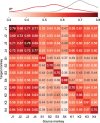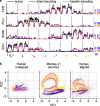From monkeys to humans: observation-basedEMGbrain-computer interface decoders for humans with paralysis
- PMID: 37844567
- PMCID: PMC10618714
- DOI: 10.1088/1741-2552/ad038e
From monkeys to humans: observation-basedEMGbrain-computer interface decoders for humans with paralysis
Abstract
Objective. Intracortical brain-computer interfaces (iBCIs) aim to enable individuals with paralysis to control the movement of virtual limbs and robotic arms. Because patients' paralysis prevents training a direct neural activity to limb movement decoder, most iBCIs rely on 'observation-based' decoding in which the patient watches a moving cursor while mentally envisioning making the movement. However, this reliance on observed target motion for decoder development precludes its application to the prediction of unobservable motor output like muscle activity. Here, we ask whether recordings of muscle activity from a surrogate individual performing the same movement as the iBCI patient can be used as target for an iBCI decoder.Approach. We test two possible approaches, each using data from a human iBCI user and a monkey, both performing similar motor actions. In one approach, we trained a decoder to predict the electromyographic (EMG) activity of a monkey from neural signals recorded from a human. We then contrast this to a second approach, based on the hypothesis that the low-dimensional 'latent' neural representations of motor behavior, known to be preserved across time for a given behavior, might also be preserved across individuals. We 'transferred' an EMG decoder trained solely on monkey data to the human iBCI user after using Canonical Correlation Analysis to align the human latent signals to those of the monkey.Main results. We found that both direct and transfer decoding approaches allowed accurate EMG predictions between two monkeys and from a monkey to a human.Significance. Our findings suggest that these latent representations of behavior are consistent across animals and even primate species. These methods are an important initial step in the development of iBCI decoders that generate EMG predictions that could serve as signals for a biomimetic decoder controlling motion and impedance of a prosthetic arm, or even muscle force directly through functional electrical stimulation.
Keywords: EMG decoding; brain computer interface; monkey; paralyzed human; transfer learning.
Creative Commons Attribution license.
Conflict of interest statement
The authors declare no competing interest.
Figures









Similar articles
-
Adaptive neuron-to-EMG decoder training for FES neuroprostheses.J Neural Eng. 2016 Aug;13(4):046009. doi: 10.1088/1741-2560/13/4/046009. Epub 2016 Jun 1. J Neural Eng. 2016. PMID: 27247280 Free PMC article.
-
Unsupervised, piecewise linear decoding enables an accurate prediction of muscle activity in a multi-task brain computer interface.J Neural Eng. 2025 Jan 29;22(1):016019. doi: 10.1088/1741-2552/adab93. J Neural Eng. 2025. PMID: 39823647 Free PMC article.
-
Validation of a non-invasive, real-time, human-in-the-loop model of intracortical brain-computer interfaces.J Neural Eng. 2022 Oct 18;19(5):056038. doi: 10.1088/1741-2552/ac97c3. J Neural Eng. 2022. PMID: 36198278 Free PMC article.
-
The state-of-the-art of invasive brain-computer interfaces in humans: a systematic review and individual patient meta-analysis.J Neural Eng. 2025 Mar 12;22(2). doi: 10.1088/1741-2552/adb88e. J Neural Eng. 2025. PMID: 39978072
-
Sensors and decoding for intracortical brain computer interfaces.Annu Rev Biomed Eng. 2013;15:383-405. doi: 10.1146/annurev-bioeng-071910-124640. Annu Rev Biomed Eng. 2013. PMID: 23862678 Free PMC article. Review.
Cited by
-
Reducing power requirements for high-accuracy decoding in iBCIs.J Neural Eng. 2024 Nov 1;21(6):066001. doi: 10.1088/1741-2552/ad88a4. J Neural Eng. 2024. PMID: 39423832 Free PMC article.
-
Neural Data Transformer 2: Multi-context Pretraining for Neural Spiking Activity.bioRxiv [Preprint]. 2023 Sep 22:2023.09.18.558113. doi: 10.1101/2023.09.18.558113. bioRxiv. 2023. PMID: 37781630 Free PMC article. Preprint.
-
Investigating the benefits of artificial neural networks over linear approaches to BMI decoding.J Neural Eng. 2025 Jun 27;22(3):036050. doi: 10.1088/1741-2552/ade568. J Neural Eng. 2025. PMID: 40527337 Free PMC article.
-
A Generalist Intracortical Motor Decoder.bioRxiv [Preprint]. 2025 Feb 6:2025.02.02.634313. doi: 10.1101/2025.02.02.634313. bioRxiv. 2025. PMID: 39975007 Free PMC article. Preprint.
References
Publication types
MeSH terms
Associated data
Grants and funding
LinkOut - more resources
Full Text Sources
Medical
